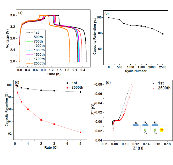Capacity Fading Mechanism of the Commercial 18650 LiFePO4-Based Lithium-Ion Batteries: An in Situ Time-Resolved High-Energy Synchrotron XRD Study
- Indiana Univ.-Purdue Univ. Indianapolis (IUPUI), IN (United States). Dept. of Mechanical and Energy Engineering. Purdue School of Engineering and Technology; Purdue Univ., West Lafayette, IN (United States). School of Mechanical Engineering
- Indiana Univ.-Purdue Univ. Indianapolis (IUPUI), IN (United States). Dept. of Mechanical and Energy Engineering. Purdue School of Engineering and Technology
- Argonne National Lab. (ANL), Argonne, IL (United States). X-ray Science Division. Advanced Photon Source
- Argonne National Lab. (ANL), Argonne, IL (United States). Chemical Science and Engineering Division
- Univ. of Pennsylvania, Philadelphia, PA (United States). Dept. of Materials Science and Engineering. School of Engineering and Applied Science
In this paper, in situ high-energy synchrotron XRD studies were carried out on commercial 18650 LiFePO4 cells at different cycles to track and investigate the dynamic, chemical, and structural changes in the course of long-term cycling to elucidate the capacity fading mechanism. The results indicate that the crystalline structural deterioration of the LiFePO4 cathode and the graphite anode is unlikely to happen before capacity fades below 80% of the initial capacity. Rather, the loss of the active lithium source is the primary cause for the capacity fade, which leads to the appearance of inactive FePO4 that is proportional to the absence of the lithium source. Our in situ HESXRD studies further show that the lithium-ion insertion and deinsertion behavior of LiFePO4 continuously changed with cycling. For a fresh cell, the LiFePO4 experienced a dual-phase solid-solution behavior, whereas with increasing cycle numbers, the dynamic change, which is characteristic of the continuous decay of solid solution behavior, is obvious. Finally, the unpredicted dynamic change may result from the morphology evolution of LiFePO4 particles and the loss of the lithium source, which may be the cause of the decreased rate capability of LiFePO4 cells after long-term cycling.
- Research Organization:
- Argonne National Lab. (ANL), Argonne, IL (United States); Indiana Univ.-Purdue Univ. Indianapolis (IUPUI), IN (United States)
- Sponsoring Organization:
- USDOE Office of Science (SC), Basic Energy Sciences (BES)
- Grant/Contract Number:
- AC02-06CH11357
- OSTI ID:
- 1461322
- Journal Information:
- ACS Applied Materials and Interfaces, Vol. 10, Issue 5; ISSN 1944-8244
- Publisher:
- American Chemical Society (ACS)Copyright Statement
- Country of Publication:
- United States
- Language:
- English
Web of Science
Similar Records
A synthesis of LiFePO{sub 4} starting from FePO{sub 4} under reducing atmosphere
A Database for Comparative Electrochemical Performance of Commercial 18650-Format Lithium-Ion Cells







